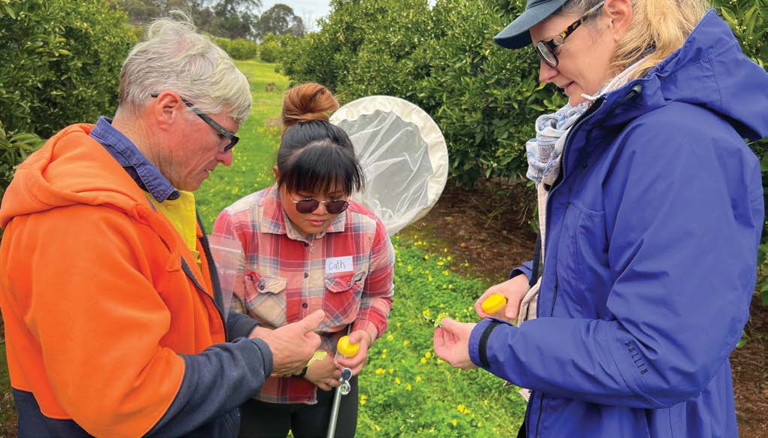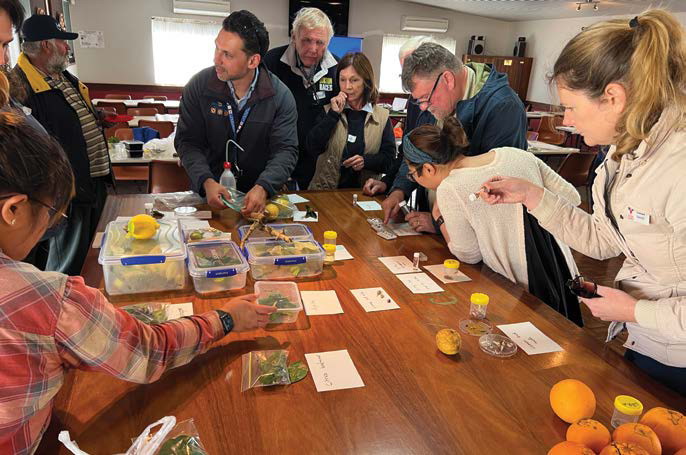Citrus IPDM workshops
focus on pest identification and monitoring

BY RACHELLE JOHNSTONE DPIRD
The Department of Primary Industries and Regional Development (DPIRD) and WA Citrus recently brought together leading citrus industry specialists to share their knowledge of pest and disease management with citrus growers.
The 2 Integrated Pest and Disease Management (IPDM) workshops in Bindoon and Harvey provided growers and field staff from northern and southern production areas along with citrus researchers and crop advisors with knowledge and skills to increase their ability to:
• Identify pests and diseases of concern and their natural enemies,
• Understand pest life cycles and how this will effect monitoring and management,
• Monitor their orchards — how, where and when to take samples and identifying pests early enough to avoid damage.
Monitoring pests and their natural enemies is a key component of IPDM.
Monitoring pests and their natural enemies is a key component of IPDM. It is a structured system for quantifying the likelihood of a pest becoming an issue in the orchard and it must be done regularly and systematically to be effective.
Cezar Moraes, Senior IPM consultant from Biological Services, demonstrated how to approach monitoring and sampling in the orchard using different techniques such as traps, a ‘beat mat’ and sweep net.
Participants used these techniques to find samples in an orchard walk.

WORKSHOP participants examining and identifying samples collected from the orchard.

1. Kevin Lacey (DPIRD) and Harvey grower Richard Eckersley search for samples.
Key tips for monitoring:
• Frequency of monitoring depends on the time of year and level of seasonal pest activity. Until you know what pests are present and when, sample at least once every 14 days.
• The stage of the crop will also influence insect activity. During high-risk periods e.g., flowering, fruit set, and as fruit is ripening, monitor more frequently. During low-risk periods, monthly monitoring is adequate.
• Sampling must be random. Do not use the same tree every time. The easiest way to randomly sample is to walk through the block in an ‘M’ shape or zigzag. Start at a new point each time that you monitor.
• Sample from four quadrants of the tree — north, south, east, and west. Take the fifth sample from the middle of the tree.
• Keeping records is important. Use a monitoring sheet or notebook out in the field and transfer to a spreadsheet to keep track of changes and patterns. Any control actions taken should also be recorded.
Participants were overwhelmingly positive about the workshops and were pleased to learn about pest identification, lifecycles and different monitoring methods and tools available, for example, the use of pheromone traps to detect light brown apple moth.
An integral part of an IPDM program is learning how to recognise pests and beneficials and understand their lifecycles. With help from attending experts and available resources workshop participants worked in small groups to map out the life stages of some pests of concern, when they occur and where they can be found in the orchard. Each group presented their findings detailing how the lifecycle would affect monitoring and management.
Participants were asked to rate their ability to identify pests and beneficials before and after the workshop. All participants indicated they had learned something from the workshop.
The workshops are part of the 4-year national Citrus Integrated Pest and Disease Management (IPDM) extension program funded by Hort Innovation to facilitate the adoption of strategies to support a profitable and sustainable citrus industry.
The workshops are part of the 4-year national Citrus IPDM extension program.
The team will be organising annual workshops as well as seasonal field walks throughout the project. Keep an eye out for our next event which will be in March, 2023 focusing on diseases.

2. Cezar Moraes demonstrates techniques for pest monitoring.

3. WA Citrus biosecurity representative Helen Newman (right) assessing pest samples with Catherina Yong and Mick Mann at the Bindoon workshop.
MORE INFORMATION
Contact Rachelle Johnstone at: rachelle.johnstone@dpird.wa.gov.au